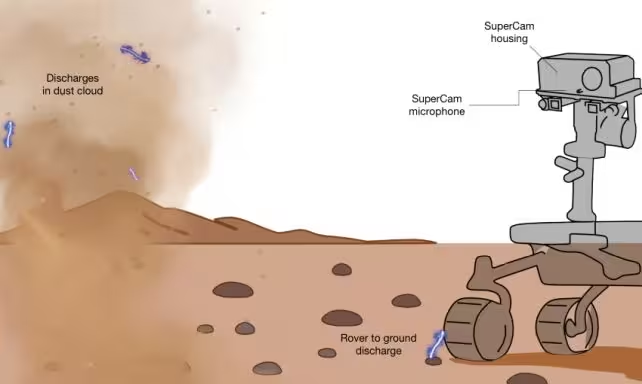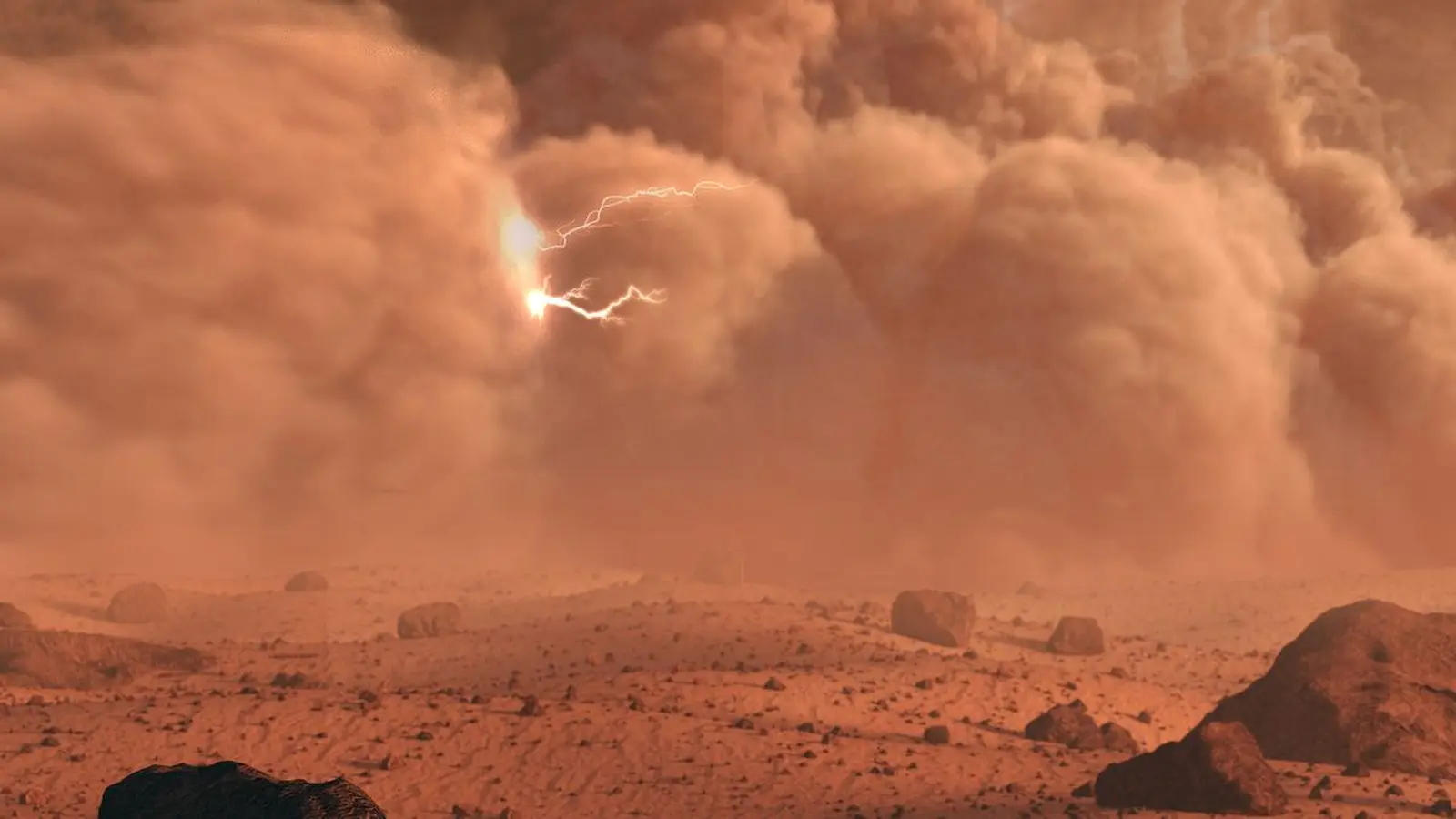6 Minutes
For the first time, a rover on Mars has captured the electrical crackle of dust-driven lightning and even tiny sonic booms — proof that the Red Planet can generate real electrical discharges during violent dusty weather. The discovery, made with NASA's Perseverance rover, reveals how wind and dust combine to spark electricity in Mars' thin, carbon-dioxide atmosphere.
How Mars makes a shock: electricity without water
Lightning on Earth is usually tied to towering, moisture-rich storm clouds. But electricity doesn't need water to form. Volcanic plumes, ash clouds and even sandstorms on Earth can build charge when particles collide and rub together. Planetary scientists long suspected similar physics could apply to Mars — despite its much thinner air and near-total lack of humidity — but direct evidence was missing.
That gap has now narrowed. Over two Martian years of monitoring, Perseverance logged 55 brief electrical events during dusty, windy conditions. Seven of those were recorded in full detail by the rover's SuperCam microphone, providing both an electromagnetic signature and a short acoustic 'ring' — a tiny thunderclap produced as heated air expands around the discharge.
Detecting the tiny sparks: SuperCam and signal fingerprints
Perseverance's SuperCam microphone was the key. Designed to record sound and pick up electromagnetic interference, the instrument registered a characteristic sequence for these events: an abrupt electronic blip as the discharge couples into the wiring, followed by an ~8-millisecond ringdown and, in seven cases, a faint acoustic pulse consistent with a miniature sonic boom.

A diagram illustrating tiny lightning discharges on Mars
To confirm the origin of these signals, researchers led experiments with a SuperCam replica in an Earth lab. Using a Wimshurst machine to generate tiny electrical discharges adjacent to the microphone replica, they reproduced the same electronic blips and ringdown profiles seen on Mars — strengthening the case that Perseverance had indeed recorded electrical discharges and not instrument noise or other artifacts.
When and where the sparks appear
Dust alone didn't guarantee electricity. Analysis shows that 54 of the 55 recorded events coincided with the top 30% of wind speeds observed by the rover, and most clustered around dust-storm fronts. Sixteen events happened during encounters with dust devils — vertical whirlwinds that loft particles and accelerate charging by collision.
Measured energies were extremely small compared with typical Earth lightning. Six of the seven acoustic events corresponded to discharges between roughly 0.1 and 150 nanojoules; one larger event reached about 40 millijoules and is consistent with a spark into the rover itself, likely caused by particles rubbing on Perseverance and building a localized charge.
Why this matters: technology, chemistry and astrobiology
Practical engineering is an immediate application. Knowing that electrical discharges — however tiny — can occur near the surface informs how future landers, habitats, and instruments should be designed and shielded against static or small sparks during dust storms and whirlwinds.
Beyond hardware, atmospheric electricity alters chemistry. On early Earth, lightning is often proposed as a driver for prebiotic chemistry — creating reactive molecules that feed pathways to life. The confirmation of lightning on Mars lets modelers include electrical reaction pathways when predicting the planet's near-surface chemistry, potentially revising estimates of reactive molecules and oxidants produced during storms.

The team used a Wimshurst machine to release tiny electrical discharges next to a replica of Perseverance's SuperCam.
Mission context and scientific methods
The study was led by planetary scientist Baptiste Chide (University of Toulouse) and colleagues, who mined 28 hours of SuperCam microphone recordings gathered across two Martian years. Their approach combined in-situ data analysis with laboratory replication and contextual environmental data from the rover — including wind speed, local dust concentration, and encounter timing with dust events — to correlate electrical activity with specific weather conditions.
The team emphasizes that most discharges occur close to the surface where pressure is relatively higher on Mars, a prediction long suggested by atmospheric models. With active surface assets like Perseverance, scientists finally have the means to validate those models directly.
Implications for future Mars exploration
Designers of future missions will need to consider how electrostatic charge builds up on wheel treads, instrument booms, and solar arrays — especially during planet-encircling dust storms or intense local dust fronts. Small sparks could corrode contacts, trigger false signals in sensors, or alter delicate experiments aimed at detecting trace organic chemistry.
Scientifically, the new evidence motivates refined atmospheric models that include electrical phenomena and their chemical consequences. This will help researchers predict oxidant production, transient chemistry during storms, and potential pathways for complex molecule formation.
Expert Insight
“These observations change how we think about Mars’ near-surface environment,” says Dr. Elena Morales, a planetary atmospheres specialist not on the study. “We now have concrete proof that transient electrical events — tied to wind and dust — occur at scales that matter for both hardware reliability and atmospheric chemistry. Future landers should be tested for electrostatic resilience under simulated Martian dust storms.”
Dr. Morales adds that integrating electrical-discharge chemistry into climate and chemical models could reveal previously overlooked reaction pathways important for understanding oxidants and trace organics on Mars.
What’s next?
Follow-up work includes targeted monitoring during peak dust seasons, use of other instruments to cross-validate electrical signatures, and expanded lab experiments simulating Martian pressure, particle composition, and wind conditions. As more surface and orbital data accumulate, researchers expect to refine energy budgets, spatial distribution, and frequency of these discharges — and assess how they might influence habitability studies and mission design going forward.
Source: sciencealert
Comments
atomwave
wow Mars can spit tiny thunder? didnt expect sonic booms there... Perseverance is a beast, those mic captures are wild, hope future gear is ready!


Leave a Comment